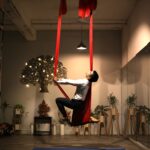Introduction to Aerial Yoga
What is Aerial Yoga? Aerial Yoga is a dynamic and innovative form of yoga that combines traditional yoga practices with elements from aerial acrobatics, Pilates, and dance. Utilizing a specially designed fabric hammock suspended from the ceiling, aerial yoga allows practitioners to explore gravity-defying poses and stretches that are difficult to achieve on the ground.
History of Aerial Yoga: Originating in the early 2000s, aerial yoga was developed to enhance the physical benefits of traditional yoga poses by adding the unique challenge and support of working against gravity. This blend of yoga and aerial arts has quickly grown in popularity, becoming a beloved practice for its holistic approach to health and wellness.
How Aerial Yoga Benefits Mental Health
Enhancing Mood: The practice of aerial yoga can significantly uplift your mood. The combination of physical activity, inversion poses, and the novelty of being suspended off the ground stimulates the release of endorphins, known as the body’s natural mood elevators.
Reducing Stress and Anxiety: Aerial yoga sessions often incorporate deep breathing exercises and mindfulness practices, which are pivotal in managing stress and anxiety levels. The focus required to maintain balance and posture in the air diverts attention from daily stressors, providing a sense of mental clarity and calm.
Improving Focus and Concentration: The necessity to concentrate on poses and balance in the aerial hammock enhances mental focus and concentration. This increased mental discipline can carry over into daily life, improving productivity and the ability to focus on tasks.
Encouraging Mindfulness and Meditation: Aerial yoga offers a unique environment for meditation and mindfulness practices. The gentle swaying of the hammock and the focus required to execute poses can lead to a meditative state, fostering a deeper connection between mind and body.
Physical Benefits Linked to Mental Well-being
Improving Flexibility: The support of the aerial hammock allows for deeper stretches and greater flexibility, which is not only beneficial for the body but also has a positive impact on mental health by reducing physical tension and enhancing feelings of well-being.
Strengthening Muscles: Aerial yoga provides a full-body workout. The resistance of the hammock combined with gravity engages core muscles, builds strength, and improves overall body tone, contributing to better mental health through improved physical health.
Enhancing Body Awareness: Practicing aerial yoga improves proprioception, or the sense of the relative position of one’s own parts of the body and strength of effort being employed in movement. This heightened body awareness can lead to improved self-esteem and body image.
Aerial Yoga for Different Populations
Aerial yoga is versatile and can be adapted for various skill levels and physical conditions, making it accessible to beginners, experienced yogis, and those with physical limitations. This inclusivity ensures that the mental and physical benefits of aerial yoga can be experienced by a wide range of individuals.
Practical Tips for Starting Aerial Yoga
For those interested in starting aerial yoga, finding a qualified instructor and a class suited to your level is crucial. Preparing for your first class involves choosing comfortable clothing, arriving with an open mind, and being ready to embrace a new challenge.
Conclusion
Aerial yoga offers a unique and engaging way to improve mental health, alongside notable physical benefits. Its holistic approach to wellness makes it an excellent choice for anyone looking to reduce stress, improve mood, and enhance overall well-being.
FAQs
- Is Aerial Yoga safe for beginners? Absolutely, with proper guidance from a certified instructor and adherence to safety precautions, aerial yoga is a safe and rewarding practice for beginners.
- How often should I practice Aerial Yoga? This varies depending on individual fitness levels and goals, but starting with 2-3 sessions a week can offer significant benefits.
- Can Aerial Yoga help with depression? Yes, the physical activity combined with mindfulness and meditation practices in aerial yoga can help alleviate symptoms of depression.
- What equipment is needed for Aerial Yoga? The primary equipment is a yoga hammock, with some classes also using additional props for specific poses.
- How does Aerial Yoga differ from traditional yoga? Aerial yoga incorporates the use of a hammock, offering a 3-dimensional movement space and the ability to perform gravity-defying poses, providing a unique and comprehensive yoga experience.
Instagram:@thepinklotusacademia
Facebook: @thepinklotusacademia
Enquire Now: Click Here
Learn more: The Pink Lotus Academia
Youtube: The Pink Lotus Academia














